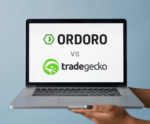Have you been thinking of starting a dropshipping business? Or do you already have an ecommerce business that you want to change into a dropshipping business? Owning a small ecommerce business might seem overwhelming at first, especially if you are shipping products to customers. But with Ordoro, you can learn how dropshipping works and have the tools to run your dropshipping business.
What is Dropshipping?
The drop shipping meaning is a simple concept that essentially means “someone else ships.” Instead of your business buying, warehousing, selling, and shipping a product to your customer, the manufacturer or distributor ships directly to the customer. The process removes a lot of the complexity of ecommerce and saves you money on shipping and housing inventory. It also saves the time it would take to ship to your retail business from the manufacturer or distributor.
How Dropshipping Works
How dropshipping works: Shopify defines dropshipping as a business where “products ship directly from the supplier to your customer, and you only pay for what you sell. No up-front inventory costs, no hassles with fulfillment.”
With dropshipping, you form a partnership with a supplier, then work with the supplier to sell their products. The order comes to your ecommerce shop, then you turn the order over to the supplier to fulfill and ship. You never have to worry about stocking, inventory, or shipping yourself. Your supplier takes on those responsibilities.
Your job is to process the order and payment. Your supplier’s job is storing the inventory, picking and packing, then shipping it to the customer.
How to Start Dropshipping from Scratch
Does dropshipping sound like a good business model for your ecommerce store? Here’s how to get started:
1. Make a commitment to starting a dropshipping business.
While starting a business isn’t a lifelong commitment, it does take some time to set up and establish it. It isn’t going to go gangbusters right from the first day.
Like most investments, starting a business takes time to really understand the process from customer order to customer fulfillment. You’ll learn:
- Practical experience of how the business operates
- Better understanding of the market and customers
- How to make better decisions
- Which products will sell and which won’t
- How to run your business successfully
Shopify suggests that you should be able to earn $1,000 to $2,000 per month within 12 months of starting your business. To get started, they advise having a $1,000 cushion for set up costs.
2. Select a dropshipping business concept.
You know you want to start a dropshipping business, but what product will you sell? This is where you need to do some market research. Niche products do well in ecommerce stores, but you know your audience best. If you are starting from scratch, you can look at Google Trends for ideas, but make sure you also use a tool like Keywords Everywhere to research traffic and competitiveness.
3. Research competitors.
Once you’ve selected a product to sell, take time researching your top competitors to see how they market. You may find some great ideas used by competitors to copy.
- Search on Google — Research keywords that customers use when they want to buy your product. Then look at the top 10 competitors for your research.
- Spy on Competitors — Use competitor spy websites like SimilarWeb to learn more about your competitors’ dropshipping websites, social media sites, traffic, and number of visitors.
- Browse Social Media — Learn how your competitors interact with their users and followers on Facebook and other social media channels.
- Subscribe to Competitor Email Lists — This keeps you up-to-date on any new dropshipping products and other news.
4. Select your supplier(s).
Now that you’ve chosen your product, you need to decide where to source it from. It’s a best practice to source your product from more than one supplier in case of shortages or shipping logistics issues.
Here is a list of supplier directories to get started.
Remember to look at shipping costs when selecting a supplier.
5. Build your ecommerce store.
It’s time to build your store. You can build it on Amazon, eBay, Shopify, or find another platform. Make sure the platform you choose has an excellent support department to help when you run into any problems. Most platforms have templates, so you don’t need to be a designer to build your shop.
6. Decide on a business structure.
If you’re serious about building a dropshipping business, then you need to set up a business structure. Options in the U.S. are sole proprietorship, limited liability company (LLC), or C corporation. You can learn more about business types on Investopedia.
For the U.S., you will have to apply for an Employer Identification Number (EIN) which acts like a Social Security number does, only for a business. This is the number the government uses to identify your business.
7. Organize your business finances.
Some entrepreneurs use their personal financial accounts to run their businesses. This isn’t a good idea. Instead, a best practice is to set up financial accounts for your business from the start. You need:
- Business Checking Account
- Business Credit Card
- Business License (required in your state)
You may also be required to collect sales taxes in your state.
8. Market your dropshipping store.
Marketing is what will drive business to your ecommerce store. Digital marketing comes in many forms, and you’ll have to decide which is the best to grow your business. Briefly, your options include:
- Paid Ads (Facebook, Google)
- Influencer Marketing
- Content Marketing
- Online Communities
- Mobile Marketing
- Search Engine Optimization
9. Analyze analytics and scale up.
Once you get a handle on your new business, you can take a look at analytics to determine what your best-sellers are and why. Use the information to adjust your products to feature the best sellers, and you may want to remove items that aren’t selling.
What Makes a Good Dropshipping Product?
Now that you’ve made a commitment to your dropshipping business, it’s time to choose products to sell. This is something you can look at when doing your market research. What are competitors selling? What has a high volume of searches?
Another place to look is the list of “trending products for 2022” or the “best dropshipping products 2022.” Here are some of the top dropshipping products.
Top 10 Products Trending for Dropshipping in 2022
- Pet supplies, food, and supplements
- Health and beauty products
- Phone accessories
- Handmade products
- Shapewear
- Smartwatches
- Activewear and leisure products
- Fine jewelry
- Baby products
- Home products
Dropshipping Suppliers
It’s important to find the best drop shipping suppliers for your dropshipping business. They need to be reliable and trustworthy so you can protect yourself and your customers.
Look for manufacturers and wholesalers in your chosen category. Check reviews on industry websites. And don’t fall for fakes and scammers. Learn more about finding reputable suppliers here.
How to Spot Fake Dropshipping Suppliers
It’s sad to say, but not every supplier listed online is legitimate. Some are scammers or fake suppliers. What steps do you need to take to spot a fake company?
- Easy to find on Google. This is one category of queries in which the fake suppliers may come up on search engine results pages (SERPs) before the legit ones. That’s because many wholesalers don’t use the best search engine optimization (SEO) tactics.
- Ongoing fees. Real drop shipping wholesalers DO NOT charge ongoing fees for using their service. They make money on the profit between the manufacturer’s and wholesaler’s costs. If they require monthly fees, they may be fake.
- They sell to the public. Real wholesalers don’t sell to the end customer for “wholesale prices.” That is a retailer just marketing to the public.
- Low-quality website. Scammers post scammy websites. While a legitimate supplier’s website might not be the most exciting, it will be professional with real information.
- Won’t sign a contract. If a supplier won’t sign an agreement to work with you, then run away quickly. A legal agreement protects you, your supplier, and your customers. Here is a sample of a supplier contract.
How Ordoro Can Help with Dropshipping
Succeeding in 2022 takes strong partnerships. Let Ordoro be your partner. Ordoro’s software helps growing merchants operate just like large-scale corporations, but at a fraction of the cost.
Optimize your fulfillment workflows with bulk shipping and label creation, omnichannel inventory management, automated dropshipping, and integrate with your current business software. You can have all this on one platform.
Ordoro allows you to focus on growing your dropshipping business in 2022, and Ordoro will help handle the back end operations including:
- Dropshipping — Ordoro offers a hands-off dropshipping workflow from setup to fulfillment to be as simplified as possible.
- Begin Dropshipping on Ordoro in Minutes — Setting up products and vendors is simple.
- Streamline Your Process — Decide how you want your process to work.
- Activate Vendor Portals — Minimize back-and-forth with vendors by allowing them to enter Ordoro.
- Custom API — You can set up custom integrations with vendors to streamline your process.
- Automation — Through auto-routing and order splitting, Ordoro’s dropshipping automation delivers on that, helping speed up your process by reducing the back-and-forth.
- Learn more from our Dropshipping Set Up Support Articles
Ordoro offers stellar customer service, you are always talking to an actual Ordoro support employee. They know how Ordoro works and how they can support you.
Other Ordoro Features for Dropshipping
- Multi-Carrier Shipping
- Multichannel Integration
- Shipping Management
- Inventory Management
- Kitting
- Pick and Pack Lists
- Automation
- Analytics
- FREE 30-Day Onboarding
- Lifetime Support
Want to Learn More about Ordoro?
Schedule a demo to learn more about how Ordoro can help support your current dropshipping business.


